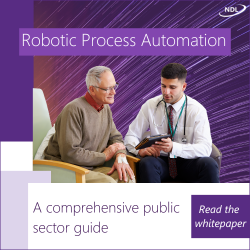It requires a lot of expertise to match the financial structures of the sector with the new commercial models of cloud providers, writes Nick Roberts, Head of Government & Public Sector at Rackspace Technology
Cloud services are a core element of the public sector’s digital foundations, but buying them can be a complex business as they are often sold on a basis that does not fit easily with the sector's financial structures.
This is testing public sector digital leaders who see the great benefits in cloud but might struggle to procure services in line with their organisations’ constraints.
The experience of this provided the background to a recent UKAuthority round table, supported by Rackspace Technology and VMware, which involved officials from local and regional authorities, the NHS and industry and highlighted key points and possible solutions. It will also be discussed at this week's UKA Live on Friday, 22 October exploring if public sector procurement is fit for the digital age.
Opex vs capex
The problems are numerous, the most frequently cited being that many public authorities allow more scope for capital expenditure while cloud services are generally sold on a revenue model that would draw on operational budgets. This is complicated by it often being difficult to predict the requirement for a service over a long period, as buyers tend to get the most from cloud by taking up extra capacity, reducing capacity or switching to other providers as and when needed.
The problem is often reinforced by the 12-month budget cycles for many organisations, with teams unsure how much they will have to spend further forward and thereby hindered in their long term planning. This undermines their ability to budget effectively and negotiate flexible long term deals with cloud providers.
It reflects an issue of mismatched timing, that the availability of money does not always align with when there is a need to buy, and it can be difficult to persuade finance chiefs to make it available for the provision of an unspecified future spend.
A prescriptive approach to funding, with finance teams making money available for specific purposes, can exacerbate the situation. Again, this restricts the flexibility to respond to new requirements or quickly obtain the benefits of a new cloud offering, especially if the money is made available for capex rather than opex.
Place-based against parochial
Further complications are arising with the growth of place based services that work across organisational boundaries. There is a tension between this and what one of the debate’s participants described as a “parochial approach to procurement and accounting” within organisations. It is not only a question about the shares of funding from each one, but how they can calculate the benefits to themselves, and how it all fits with their own procurement cycles.
The debate suggested there have been different experiences in different regions in dealing with this, that in some places solutions have been found while in others it is almost impossible to get organisations with common needs working together.
Along with this came a consensus that cloud providers have so far shown little inclination to adjust their commercial models to make it easier for public sector customers. They are most likely to stick with what works best for them – the deals which provide a stream of revenue rather than a need for long term deals – while public bodies are often dealing with them individually and lack the buying power to persuade them into a different approach.
As one participant pointed out, the key issue is around how organisational finances are structured, which tends to shape procurement, and that for local government in particular it is becoming more difficult to fill all the gaps. This amounts to a set of problems that can cut organisations off from innovations in cloud services that could do a lot to help them deal with their challenges.
Nobody has claimed there are easy solutions, but the debate brought up a few positive possibilities.
Fuzzy rules
One is in the perception that there are often “fuzzy rules around edge” of what can be classed as capex, and the digital leaders can work with their finance colleagues on what cloud spending could qualify. There are limitations to this approach but it has more chance of being applied if there is a decent element of predictability in the use of a service.
Another derives from the view within some organisations that they are using too many approaches and frameworks for procurement, that this makes it difficult to assess best value and they would get a clearer picture through a simplified route. In turn, this would enable a better dialogue between digital and finance teams to give the former flexibility in their spending.
It is a complicated process that would take time to yield results, but it could open up new possibilities for procuring cloud services.
An alternative is for a national initiative to provide a common approach to procurement for organisations using similar services, as seen in the deal for Microsoft 365 licensing to NHS bodies. Replicated across the public sector this would provide some certainty for both sides of the market and give the public sector more weight for flexible, good value terms.
A less formal approach of organisations sharing information on how they found new paths in procurement – similar to the sharing of success stories for service development – could also contribute. This has been under-utilised in the field but reflects the wider benefits of councils, NHS bodies or police forces just talking more with each other about what works - and what doesn't.
Then there is a scope for more shared procurement, possibly on a regional basis, providing the strength in numbers for better deals. It comes with the complexity of organisations needing to remain flexible in when and how much they use a specific service, but easily accessible framework contracts should provide a mechanism for finding the right balance.
A third way?
Finally comes the idea of talking with suppliers about a “third way”, one which works for them commercially while simplifying the outlook for public bodies. One participant speculated on whether a quality or outcomes based approach would work, and others looked favourably on the idea of a new model – but with uncertainty as to whether it is achievable.
For now the situation is highly challenging with a need to navigate difficult financial structures and wide variations in supplier pricing models. This is where a trusted adviser such as Rackspace Technology can play a crucial role in ensuring a public authority gets the best value for money coupled with the most effective solutions from the cloud market.
The company has extensive experience of working with the hyperscalers and smaller, more specialised providers, and in supporting public sector bodies with tight financial and procurement rules. It places a premium on the diversity in the market, helping to steer organisations towards the best offerings and manage their migration in and out of services – and can tell suppliers how it wants them to work for its customers.
The key for this is in the expertise that Rackspace Technology can provide.
Find out more about Rackspace UK Public Sector Cloud on VMware
Register here to join us on Friday, 22 October for our UKA Live: Is public sector procurement fit for the digital age?
On the panel
- Bobby Mulheir, Assistant Director: Customer Experience, Digital & ICT, Bracknell Forest Borough Council
- Owen Powell, ICT Director, Central and North West London NHS Foundation Trust
- Nick Roberts, Head of Government & Public Sector, Rackspace Technology
- Geoff Connell, Director of IMT & Chief Digital Officer, Norfolk County Council
- Joseph Langford, Chief technologist public sector, VMware
- Helen Olsen Bedford, Publisher, UKAuthority

Image from iStock, Thitchaya Yajampa





